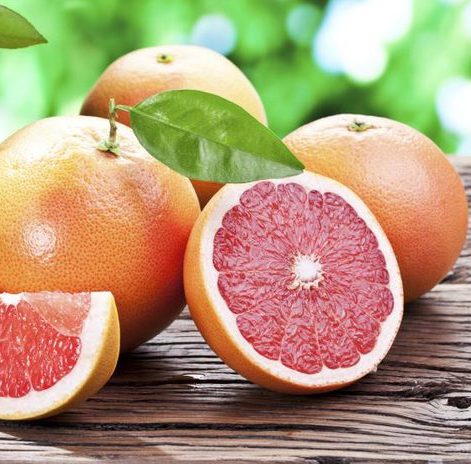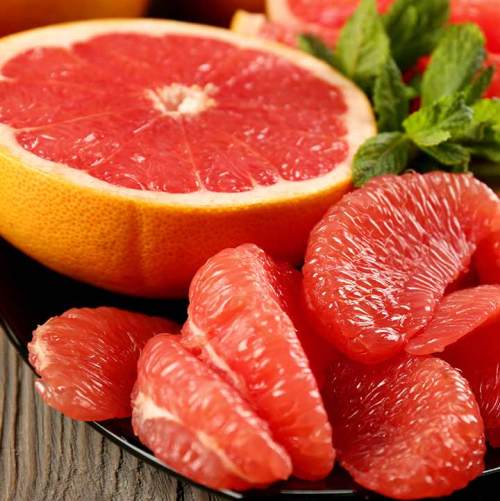-Essential-Oil.png)
-Essential-Oil.png)




Botanical name Citrus racemosa
Family Rutaceae
Source Peel
Origin Italy
Processing Method Cold Pressed
Color/Consistency A thin, Pale yellow to reddish orange liquid.
Aromatic Summary / Note / Strength of Aroma A middle note with a medium aroma, Grapefruit Pink has a fresh, sweet citrus smell that is very characteristic of the fruit.
Blends With Grapefruit Pink blends well with other members of the citrus family, Rosemary, Cypress, Lavender, Geranium, Cardmom and generally most spice oils.
Product Abstract
Grapefruits vary in color from white or yellow to pink and red. They can range in taste from acidic and even bitter to sweet and sugary.
These fruits support clear, healthy skin, can help to lower our risk for many diseases and conditions, and may even help with weight loss as part of a healthy and varied diet. The juices, peels, and pulps all provide nutritional benefit.
History
The genetic origin of the grapefruit is a hybrid mix. One ancestor of the grapefruit was the Jamaican sweet orange (Citrus sinensis), itself an ancient hybrid of Asian origin; the other was the Indonesian pomelo (C. maxima). One story of the fruit's origin is that a certain "Captain Shaddock" brought pomelo seeds to Jamaica and bred the first fruit,however, it probably originated as a naturally occurring hybrid between the two plants some time after they had been introduced there. The hybrid fruit, then called "the forbidden fruit", was first documented in 1750 by a Welshman, Rev. Griffith Hughes, who described specimens from Barbados in The Natural History of Barbados
Harvesting/Extraction Information
The effects of harvest date (four 3-week-spaced dates from early May to end of June) and storage temperature (6 and 10 °C) on grapefruit weight loss, decay and internal quality were evaluated at two given periods (early July and end of August). Harvest dates were before flowering, at full bloom, after flowering and 6 weeks after full bloom.
Common Usage
Caution
This Essential Oil has phototoxic properties and exposure to the sun must be avoided after application to the skin. Due to their presence, please consult a physician prior to using this oil. Dilute well before use; May cause skin irritation in some individuals; a skin test is recommended prior to use. Contact with eyes should be avoided.
Key constituents
(þ)-Limonene 84.8–95.4%
b-Myrcene 1.4–3.6%
a-Pinene 0.2–1.6%
Sabinene 0.4–1.0%
Nootkatone 0.1–0.8%
Non-volatile compounds
Bergapten 0.012–0.19%
Epoxy-bergamottin 0.1126%
Bergamottin <0.11%
Quality Grapefruit oil may be adulterated with orange terpenes, or with purified limonene.
Safety summary
Hazards Phototoxic (low risk); skin sensitization if oxidized. Contraindications (dermal): If applied to the skin at over maximum use level skin must not be exposed to sunlight or sunbed rays for 12 hours.
Cautions Old or oxidized oils should be avoided. Maximum dermal use level: 4%
Our safety advice
Because of its (þ)-limonene content we recommend that oxidation of grapefruit oil is avoided by storage in a dark, airtight container in a refrigerator. The addition of an antioxidant to preparations containing it is recommended.
Regulatory guidelines
Has GRAS status. In Europe, essential oils containing furanocoumarins must be used so that the total level of bergapten will not exceed: (a) 15 ppm in finished cosmetic products intended for application to skin areas likely to be exposed to sunshine, excluding rinse-off products; or (b) 1 ppm in sun protection and in bronzing products. In the presence of other phototoxic ingredients, the sum of their concentrations (expressed as % of the respective maximum levels) shall not exceed 100%.
Organ-specific effects
Adverse skin reactions Undiluted grapefruit oil was slightly irritating to rabbits, but was not irritating to mice or pigs. Tested at 10% or 100% on two panels of 25 volunteers it was not irritating. Tested at 10% on 25 volunteers it was not sensitizing. It is non-phototoxic. Autoxidation products of (þ)-limonene can cause skin sensitization.
Reproductive toxicity The low developmental toxicity of (þ)-limonene in rabbits and mice suggests grapefruit oil is not hazardous in pregnancy.
Systemic effects
Comments
Phototoxicity is due to bergapten, and other furanocoumarins found in the oil.